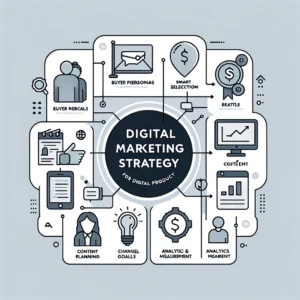In an era where technology continually reshapes our world, the realms of software and digital product development stand as pivotal forces driving innovation. This domain, intricate and dynamic, is not just about coding or programming; it’s about creating digital solutions that resonate with users and thrive in competitive markets. The importance of software and digital product development cannot be overstated – it’s the backbone of the digital transformation that influences every aspect of our lives, from the way we communicate to how we work and entertain ourselves. But what exactly entails in this ever-evolving field? This article delves into the core of software and digital product development, exploring its fundamental principles, processes, challenges, and the emerging trends shaping its future.

Understanding the Basics of Digital Product Development in Software Realms
What is Software and Digital Product Development?
Software and digital product development is an intricate process that involves conceptualizing, designing, building, and maintaining applications or systems that run on computers or other digital devices. It’s not just about writing code; it encompasses a comprehensive approach that includes understanding user needs, designing user interfaces, testing, and continuous improvements. This field is diverse, covering everything from web and mobile applications to complex enterprise software and innovative digital tools.
Key to this process is the alignment of technology with user needs and business goals. Successful digital products not only solve specific problems but also provide an engaging user experience, meet quality standards, and have scalability. In essence, software and digital product development is a marriage of technology, creativity, and strategic planning, aiming to deliver value to users and stakeholders alike.
Key Principles of Effective Digital Product Development
The success of software and digital products hinges on several key principles:
- User-Centric Design: Understanding the end-user’s needs and preferences is paramount. This involves user research, persona development, and usability testing to ensure the product is intuitive, accessible, and enjoyable.
- Agile Methodology: Embracing flexibility in the development process allows teams to adapt to changes, iterate quickly, and deliver functional increments of the product regularly.
- Quality Assurance: Rigorous testing for functionality, performance, security, and compatibility is crucial to ensure the product is reliable and meets industry standards.
- Continuous Improvement and Innovation: The digital world is fast-paced. Ongoing updates, enhancements, and adaptation to emerging technologies keep the product relevant and competitive.
- Collaborative Teamwork: Effective product development requires a blend of diverse skills and perspectives. A collaborative approach fosters innovation and efficient problem-solving.
These principles form the foundation of robust software and digital product development, guiding teams in creating products that not only meet but exceed user expectations and stand out in the digital marketplace.
The Software Development Life Cycle (SDLC): A Roadmap for Success
Phases of the SDLC
The Software Development Life Cycle (SDLC) is a systematic process used for developing software applications. It ensures project clarity and effective management throughout the software creation process. Here are the key phases:
- Requirement Analysis: This initial stage involves understanding and documenting the software requirements, establishing the what and why behind the project.
- Design: Based on the requirements, the software’s architecture and design are planned. This stage addresses how the software will meet the specified requirements.
- Implementation/Coding: The actual development of the software takes place in this phase, where programmers write code according to the previously defined design.
- Testing: After coding, the software undergoes rigorous testing to identify and fix any bugs or issues, ensuring the software functions as intended.
- Deployment: Once the software passes all tests, it is deployed for use. Depending on the project’s nature, this could be a staged or a full launch.
- Maintenance: Post-deployment, the software needs regular updates and maintenance to adapt to new requirements or fix any arising issues.
How SDLC Guides Digital Product Development?
The SDLC provides a structured approach that helps teams manage complex software development projects with greater efficiency and predictability. Here’s how:
- Risk Management: By breaking down the process, the SDLC allows teams to address risks early, reducing the potential for major setbacks later.
- Quality Control: Continuous testing at each stage ensures the product’s quality, functionality, and alignment with user needs.
- Stakeholder Engagement: Regular reviews and updates keep stakeholders informed and involved, ensuring their needs and expectations are continually met.
- Resource Optimization: Clear phases and milestones enable better planning and allocation of resources, from time to personnel and budget.
- Adaptability: While structured, the SDLC is flexible enough to accommodate changes, a crucial aspect in the dynamic field of software development.
Understanding and effectively applying the SDLC is crucial for any team aspiring to develop successful software products. It not only streamlines the development process but also ensures the delivery of high-quality, user-centric software solutions.
Innovative Strategies in Digital Product Development
Embracing Agile Methodologies
One of the most transformative strategies in software and digital product development is the adoption of Agile methodologies. Agile is a mindset and approach that emphasizes flexibility, continuous improvement, and delivering functional product increments quickly and frequently. Here are some key aspects:
- Iterative Development: Agile promotes developing software in small, manageable increments, allowing for frequent feedback and adjustments.
- Collaborative Teamwork: Cross-functional teams work collaboratively, with regular communication and close coordination, fostering a productive and innovative environment.
- Customer Feedback: Regular input from users or stakeholders is integral, ensuring the product evolves in a way that truly meets their needs.
- Adaptive Planning: Agile encourages responsiveness to change, allowing teams to pivot or make adjustments as needed throughout the development process.
By incorporating Agile methodologies, teams can increase productivity, enhance product quality, and ensure greater customer satisfaction.
Importance of User-Centered Design
User-Centered Design (UCD) is another pivotal strategy in digital product development. It places the user at the forefront of the development process, ensuring that the final product is not only functional but also intuitive and enjoyable to use. Key elements include:
- User Research: Gathering insights about the target audience’s behaviors, needs, and motivations.
- Prototyping and Testing: Creating interactive models of the product for user testing, gathering feedback to refine and improve the design.
- Accessibility and Usability: Ensuring the product is accessible to all users, including those with disabilities, and focusing on a seamless, user-friendly experience.
- Design Thinking: Applying a problem-solving approach that encourages empathy with users, ideation, and iterative testing.
Incorporating UCD principles leads to products that resonate more deeply with users, driving engagement and satisfaction.
Challenges and Solutions in Software Product Development
Common Roadblocks in the Development Process
Even with the best planning and strategies, software product development can encounter several challenges. Understanding these common roadblocks is crucial to navigate them effectively:
- Changing Requirements: As market trends and user needs evolve, requirements can change, potentially disrupting the development timeline and scope.
- Technical Debt: Accumulation of code that, due to short-term solutions, becomes difficult to maintain or build upon.
- Resource Constraints: Limited budget, time, or human resources can impede the development process.
- Integration Issues: Challenges in integrating new software with existing systems or third-party services.
- Security Concerns: Ensuring robust security measures are in place to protect the software and its users.
Strategies to Overcome These Challenges
To address these challenges, several strategies can be adopted:
- Flexible Planning: Employing Agile methodologies to accommodate and adapt to changing requirements.
- Regular Code Refactoring: Consistently revisiting and improving the codebase to reduce technical debt.
- Efficient Resource Management: Prioritizing tasks and utilizing resources effectively to meet development goals within constraints.
- Robust Testing and Integration Practices: Ensuring thorough testing and employing best practices for integration to minimize issues.
- Prioritizing Security: Integrating security considerations into the development process from the beginning.
By anticipating and preparing for these challenges, teams can enhance their resilience and ensure the successful completion of their software development projects.
Emerging Trends in Software and Digital Development
The landscape of product and development in the software and digital domains is constantly evolving. Staying abreast of these trends is essential for developers, project managers, and stakeholders to ensure their products remain relevant and competitive. Here are some key trends shaping the future of product and development in this field:
The Role of Artificial Intelligence and Machine Learning
Artificial Intelligence (AI) and Machine Learning (ML) are revolutionizing the approach to product and development in software. These technologies are enabling more intelligent, adaptive, and user-centric products. Here’s how they’re impacting product and development:
- Enhanced User Experience: AI algorithms can personalize user experiences, making digital products more intuitive and responsive to individual user needs.
- Streamlined Development Processes: AI and ML can automate mundane tasks, analyze code for errors, and even assist in complex problem-solving, speeding up the product and development cycle.
- Predictive Analytics: Incorporating predictive analytics in product and development allows for better decision-making, foreseeing market trends, and user behavior predictions.
The Future of Cloud-Based Development
Cloud-based development is another trend significantly impacting product and development strategies. The cloud offers flexibility, scalability, and collaboration benefits that are transforming how digital products are developed. Key aspects include:
- Enhanced Collaboration: Cloud platforms enable teams to collaborate more effectively, regardless of location, facilitating a more cohesive product and development process.
- Scalability and Flexibility: Cloud services allow for easy scaling of resources, making it simpler to adjust as the product and development needs change.
- Cost-Effectiveness: With cloud computing, companies can optimize their spending on IT infrastructure, channeling more resources into the core areas of product and development.
Keeping pace with these trends is crucial for anyone involved in software and digital product and development, ensuring that their products not only meet current demands but are also future-ready.
Conclusion
In conclusion, the landscape of product and development in the realm of software and digital technologies is a dynamic and ever-evolving field. The success in this arena is not just about keeping pace with technological advancements but also about understanding and implementing best practices in product and development processes. From embracing agile methodologies and user-centered design to overcoming common development challenges and staying ahead of emerging trends like AI, ML, and cloud-based development, each aspect plays a crucial role in shaping successful digital products.
As we look to the future, the importance of innovative approaches in product and development cannot be overstated. The integration of advanced technologies and methodologies will continue to drive the evolution of this field. For businesses, developers, and stakeholders, staying informed and adaptable is key to navigating the complexities of software and digital product and development. Ultimately, the goal remains clear: to develop products that are not only technologically advanced but also deeply resonate with users, offering them value, efficiency, and an enhanced digital experience.
In this journey of product and development, the blend of creativity, technical prowess, and strategic insight will continue to be the cornerstone of creating groundbreaking software and digital solutions that shape our world.
Freagently asked question about Software and Digital product developement
How do security considerations impact product development?
Security is a critical aspect of product development, requiring integration of robust security measures from the start. This protects the software and its users from potential threats and vulnerabilities.
What emerging trends are shaping software product development?
Key trends include the integration of Artificial Intelligence and Machine Learning for enhanced functionality and predictive analytics, as well as the adoption of cloud-based development for improved collaboration and scalability.
What role does User-Centered Design play in product development?
User-Centered Design ensures that the final product is intuitive, accessible, and enjoyable. It involves user research, prototyping, testing, and focuses on creating a seamless user experience.
What are the common challenges in software product development?
Common challenges include changing requirements, technical debt, resource constraints, integration issues, and security concerns. Strategies like flexible planning and regular code refactoring can help overcome these challenges.
How do Agile methodologies benefit product development?
Agile methodologies offer flexibility and adaptability in the development process. They emphasize iterative development, collaborative teamwork, and regular customer feedback, leading to higher productivity and better alignment with user needs.
Why is the Software Development Life Cycle (SDLC) important?
The SDLC provides a structured approach to software development, helping manage complex projects efficiently. It guides teams through different phases, from requirement analysis to maintenance, ensuring quality and reducing risks.
What is Software and Digital Product Development?
Software and digital product development is the process of conceptualizing, designing, building, and maintaining software applications or systems. It involves not just coding, but also understanding user needs, creating user interfaces, testing, and continuous improvement.
What does continuous improvement entail in product development?
Continuous improvement in product development means regularly updating and refining the product based on customer feedback, market trends, and technological advancements. This process is crucial for keeping the product relevant, competitive, and in line with evolving market demands.
Why is a product roadmap important?
A product roadmap is a strategic document that outlines the future direction and milestones for a product. It is important because it guides long-term development, helps in aligning the team with business goals, and ensures the product adapts to changing market conditions and customer needs.
How does test marketing differ from final market launch?
Test marketing involves releasing the product to a controlled, limited audience to evaluate its performance, gather feedback, and make necessary adjustments. It’s a preliminary step before the final market launch, which is a broader, full-scale release of the product to the general market.
What role do stakeholders play in the product development process?
Stakeholders, including customers, investors, team members, and suppliers, provide diverse perspectives and feedback during the product development process. Their input is vital in ensuring that the product meets market needs, aligns with business objectives, and is feasible from a production and financial standpoint.
Can you explain the importance of prototyping in product development?
Prototyping is essential in product development as it provides a tangible representation of the product idea. It allows teams to test and refine the design, functionality, and user experience before full-scale production. Prototypes help in identifying potential issues early, saving time and resources.
What is a Product Requirements Document (PRD) and why is it important?
A Product Requirements Document (PRD) outlines the product’s intended features, specifications, and the problems it aims to solve. It is important because it serves as a blueprint for the development team, aligning their efforts and ensuring that the final product meets the initial vision and customer needs.
How important is market research in the product development process?
Market research is crucial as it guides the development process by providing insights into consumer needs, market trends, and the competitive landscape. It helps in identifying the target market, understanding customer preferences, and positioning the product effectively in the market.
What is the SCAMPER method, and how is it used in product development?
SCAMPER is an acronym representing different ways you can alter existing products or ideas to create new ones. It stands for Substitute, Combine, Adapt, Modify, Put to another use, Eliminate, and Reverse. In product development, this method is used to stimulate creative thinking and generate innovative ideas by looking at existing products or concepts in new ways.
What is Product Management?
Product management is a critical function within a company that involves the planning, development, and marketing of products or services. Product managers are responsible for guiding a product through its entire lifecycle, from conception and design to development, launch, and ongoing improvement. Their primary goal is to create products that meet customer needs and achieve business objectives.
Key responsibilities of a product manager typically include:
- Market Research: Product managers conduct market research to understand customer needs, industry trends, and competition. They use this information to identify opportunities and gaps in the market.
- Product Strategy: Product managers develop a strategic vision for their product, outlining its goals, target audience, and value proposition. This includes defining the product’s positioning and its unique selling points.
- Product Planning: They create a product roadmap, which outlines the product’s features and development timeline. This roadmap helps align cross-functional teams on the product’s priorities.
- Prioritization: Product managers must prioritize which features and improvements to work on first. This often involves balancing customer feedback, business goals, and technical constraints.
- Development Oversight: They work closely with development teams, often using agile methodologies, to ensure that the product is built according to the specifications and timelines outlined in the roadmap.
- Testing and Quality Assurance: Product managers are responsible for ensuring the product meets quality standards and undergoes testing to identify and resolve issues.
- Go-to-Market Strategy: They create plans for product launches, including marketing and sales strategies, pricing, and distribution.
- Feedback and Iteration: Product managers collect and analyze user feedback and usage data to make continuous improvements to the product. They iterate on the product to respond to changing market conditions and customer needs.
- Cross-Functional Collaboration: They work with various departments, such as engineering, design, marketing, and sales, to coordinate efforts and ensure everyone is aligned on the product’s goals.
- Financial Management: Product managers often manage the financial aspects of a product, including budgeting and forecasting, to ensure that the product remains profitable.
Product management is a dynamic and multifaceted role that requires a combination of business acumen, technical knowledge, and the ability to communicate effectively across teams. Successful product managers must be customer-focused and able to adapt to changing market conditions to drive the success of their products.



